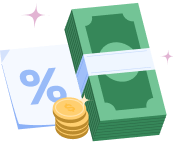Table of Contents
Nearly 60% of Americans live paycheck to paycheck, even high earners. This pattern traps many in financial stress, limits opportunities, delays goals, and creates anxiety. Understanding the causes is the first step toward lasting financial freedom.
Many people assume that earning more guarantees financial stability, but rising living costs, lifestyle inflation, and mounting debt can easily offset salary increases. Without clear financial strategies, it is easy to remain stuck in the paycheck-to-paycheck cycle, even with a comfortable income.
Understanding the Paycheck-to-Paycheck Cycle
The paycheck-to-paycheck cycle is more common than people realize. It combines behavioral tendencies like instant gratification and poor planning with external pressures like inflation, creating a recurring loop that keeps income from building long-term financial security.
Living paycheck to paycheck means spending nearly all of your earnings before the next payday. It often starts with small financial pressures, such as rent, credit card debt, or unexpected expenses, but grows with behavioral patterns and poor money management.
Psychological factors like instant gratification, fear of missing out, and impulsive spending keep many individuals trapped. It is also important to understand that financial struggles are often less about income and more about managing the money you already earn effectively.
Why So Many People Fall Into the Trap
Many individuals fall into the paycheck trap due to subtle yet persistent factors like lifestyle inflation, lack of emergency savings, and over-reliance on credit or BNPL options, which steadily erode financial stability over time.
Lifestyle Inflation Creeps In Quietly
Lifestyle inflation occurs when every raise or bonus leads to higher spending instead of increased savings. Upgrading phones, leasing newer cars, or adding more streaming subscriptions may feel like a reward, but these incremental increases in spending often match salary growth, leaving net worth unchanged. Over time, lifestyle inflation silently reinforces the paycheck-to-paycheck cycle.
Lack of Emergency Cushion
An emergency fund is a financial buffer that protects against unexpected costs. Without one, a single medical bill, car repair, or urgent expense can wipe out savings and restart the paycheck cycle. Building even a small emergency fund in a High-Yield Savings Account (HYSA) ensures you are prepared for sudden expenses and can earn interest while doing so.
Over-Reliance on Credit Cards and BNPL Services
Relying on credit cards or Buy Now Pay Later (BNPL) services may offer temporary relief, but often leads to deeper financial dependency. High-interest balances and recurring payments reduce available cash and trap individuals in continuous debt repayment. Using responsible short-term cash alternatives, such as Beem Instant Cash, provides a safer way to bridge gaps without incurring high costs.
The Hidden Costs of Living Paycheck to Paycheck
Living paycheck to paycheck carries invisible costs, including anxiety, missed investment opportunities, and higher borrowing expenses. These hidden consequences reduce quality of life and slow wealth accumulation, even for those with seemingly sufficient income.
Constant Anxiety and Mental Load
Financial instability creates stress that affects sleep, relationships, and mental clarity. Worrying about bills, unexpected expenses, or overdrafts produces ongoing anxiety and can lead to poor decision-making, perpetuating the cycle and breaking free restores both financial and emotional stability.
Missed Investment and Growth Opportunities
Without savings, investing becomes impossible, and opportunities for compounding and wealth growth are lost. Living paycheck to paycheck prevents contributions to retirement accounts and other long-term financial goals, slowing wealth accumulation and limiting future security.
Higher Long-Term Borrowing Costs
Irregular payments or maxed-out credit cards harm credit scores, resulting in higher interest rates for loans and credit products. Over time, this increases the cost of borrowing for essentials like cars, mortgages, or personal loans. Using the Beem Card as a no-fee, credit-builder alternative helps improve credit and reduces future financial burdens.
Signs You Might Be Caught in the Cycle
There are clear signs you may be trapped in the paycheck cycle, such as running out of money early, relying on credit, or failing to grow savings. Recognizing these indicators is essential for taking control of your finances.
Common signs include depending on overdraft accounts or cash advance apps to cover regular expenses, having little to no emergency savings, or noticing that your savings balance never grows despite a steady income. Being aware of these patterns is the first step toward breaking free and creating a stable financial foundation.
How to Break Free From the Paycheck-to-Paycheck Trap
Escaping the paycheck trap requires deliberate action, including auditing cash flow, building buffers, automating savings, reducing recurring expenses, and managing debt strategically. These steps empower long-term financial control and break the cycle gradually but effectively.
Step 1 — Audit Your Cash Flow Honestly
Track every dollar for at least one month to identify unnecessary spending. Awareness is the first step in gaining control over money. Tools like Beem AI Wallet provide automatic insights and visual tracking, making it easier to spot spending leaks and opportunities to save.
Step 2 — Create a Buffer Fund Before Anything Else
Set aside at least one week’s worth of essential expenses as a mini-emergency fund. It prevents small financial shocks from derailing your budget. Placing this fund in a HYSA can provide modest returns while ensuring funds are safe and accessible.
Step 3 — Automate Savings and Bill Payments
Treat savings as a fixed expense, not a leftover. Automate transfers to your savings account and set up automatic bill payments to avoid late fees. Automation ensures consistency and reduces decision fatigue.
Step 4 — Reduce Recurring Expenses Without Losing Joy
Audit subscriptions and recurring charges to eliminate unnecessary spending. Switch to annual plans, share memberships, or consolidate services to save money. Tools such as Beem BudgetGPT can help identify hidden charges and optimize monthly spending.
Step 5 — Rethink Debt Usage
Stop relying on credit cards to cover everyday expenses. Focus on consolidating or refinancing high-interest debt to lower monthly payments. The goal is to manage debt strategically rather than letting it dictate your budget.
Building Sustainable Financial Habits
Long-term financial stability comes from sustainable habits, including spending below your means, paying yourself first, and diversifying income. These consistent practices prevent setbacks, create security, and allow incremental growth without relying on temporary fixes.
Live Below, Not Up to, Your Means
Consistently spending less than you earn is the foundation of financial freedom. Avoid using raises to increase lifestyle expenses. Instead, allocate additional income toward savings, debt repayment, or investment accounts to create long-term security.
Pay Yourself First
Set up automated transfers to save a fixed percentage of your income before spending on anything else. For example, transfer 10% of every paycheck to a HYSA or investment account. This habit ensures steady growth of your savings without relying on willpower.
Build Multiple Income Streams
Diversifying income reduces vulnerability to financial shocks. Freelance work, monetizing hobbies, or pursuing side hustles, such as JobsGPT opportunities, provide additional cash flow. Multiple income sources also accelerate savings and provide flexibility during emergencies.
How AI and Smart Tools Can Help You Stay on Track
AI tools and smart financial apps provide automation, personalized insights, and timely reminders. They help people maintain budgets, monitor spending, and achieve goals efficiently while reducing decision fatigue and strengthening overall financial discipline.
Platforms like Beem AI Wallet and BudgetGPT can analyze spending, track progress, and send reminders for low balances or upcoming bills. Automation ensures consistency, turning intelligent prompts into an accountability system that keeps users on track toward financial stability without manual effort.
Real-World Example — From Surviving to Saving
Real-life examples show that small, consistent changes such as tracking expenses, automating savings, and eliminating wasteful spending can transform someone living paycheck to paycheck into someone steadily building financial security over months.
For instance, someone earning $3,000 a month and previously struggling to cover bills could start by tracking spending and identifying $250 of unnecessary expenses. By automating $50 weekly into a HYSA and using Beem AI Wallet to monitor cash flow, they could save $1,200 and pay off a credit card within six months. Small, consistent actions create meaningful change.
Conclusion — Replace Stress With Stability
Breaking the paycheck-to-paycheck cycle requires awareness, control, and consistent action. By adopting disciplined financial habits and leveraging smart tools, anyone can replace financial stress with stability, confidence, and long-term independence.
Using Beem AI Wallet and Beem Instant Cash responsibly helps manage cash flow, save smarter, and maintain progress. With awareness, automation, and steady habits, it is possible to stop the cycle and create lasting financial freedom. Download the Beem app here.
FAQs on Living Paycheck to Paycheck
Why do even high-income earners live paycheck to paycheck?
Because spending tends to rise with income, without strong budgeting or saving discipline, even large salaries can disappear quickly due to lifestyle inflation and unmanaged expenses.
How can I start saving if I barely make ends meet?
Begin small by setting aside $10 to $20 weekly in a separate HYSA. Consistent saving builds momentum and confidence, helping establish long-term financial habits.
What’s the first step to stop living paycheck to paycheck?
Track your expenses honestly to identify unnecessary spending. Awareness is always the first step toward better budgeting and financial control.
Is using a cash advance app a bad idea?
Not necessarily if it is transparent and interest-free, responsible alternatives like Beem Instant Cash can provide short-term relief without high costs or risk of deepening debt.
How long does it take to break the paycheck cycle?
With consistent budgeting, saving, and reducing spending, most people can feel noticeable relief within three to six months, establishing a foundation for long-term financial stability.
















































